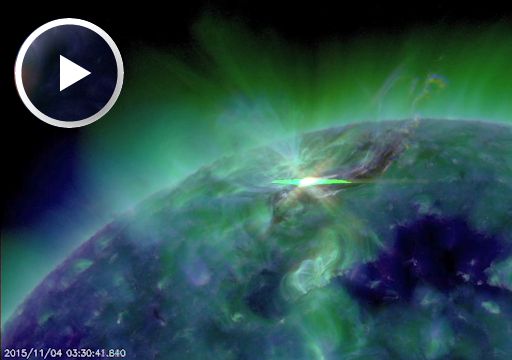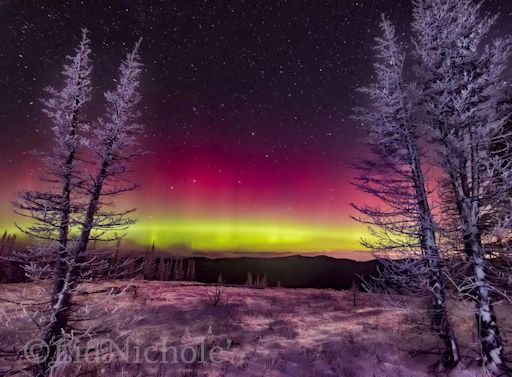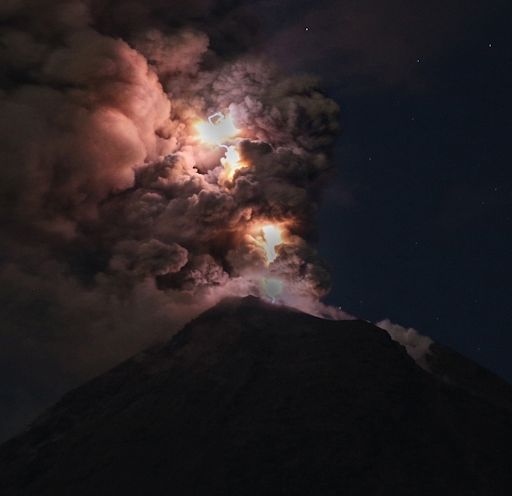Marianne's Heaven On Earth Aurora Chaser Tours Chasethelighttours.co.uk invites you to join them in their quest to find and photograph the Aurora Borealis. Experience the winter wonderland in the Tromsø Area. | | | EXPLOSION RISES, FALLS BACK TO THE SUN: Sunspot AR2445 erupted during the early hours of Nov. 4th--but the blast lacked "umph." Much of the material hurled aloft by the explosion fell back to the surface of the sun. Click to view a movie from NASA's Solar Dynamics Observatory: 
The flash of electromagnetic radiation shown in the movie registered M1.9 on the Richter Scale of Solar Flares. Plasma rushed away from the blast site, as usual, but only a fraction of it escaped. A dark magnetic filament connected to the underlying sunspot may have interfered with the escape. SOHO has recorded only a minor CME emerging from the area, and it is not heading for Earth. Solar flare alerts: text or voice AURORAS OVER THE USA: A unusual stream of solar wind is buffeting Earth's magnetic field, causing G1-class geomagnetic storms around the poles. The stream is unusual not only because it is very fast (700+ km/s), but also because it has a series of shock waves or "transients" embedded in it--at least 3 so far. Sudden changes in solar wind pressure have sparked auroras in multiple US states, like these over Ellensburg, Washington, on Nov. 3rd: 
"Last night was amazing," says photographer Lia Simcox. "I hurried up to my favorite spot and was not only greeted with Northern Lights, but snow as well! What an absolutely gorgeous sight." Elsewhere in the USA, auroras were sighted in Michigan, Wisconsin, Montana, Massachusetts, Oregon, and Ohio. In those areas, subscribers to our space weather alert service received wake-up calls when the auroras appeared. More auroras are possible tonight as the solar wind continues to blow. NOAA forecasters estimate an 70% chance of polar geomagnetic storms on Nov. 4th, waning to 35% on Nov. 5th when Earth begins to exit the solar wind stream. Aurora alerts: text or voice Realtime Aurora Photo Gallery VOLCANIC LIGHTNING IN MEXICO: In southern Mexico, the Colima volcano has been in a state of near-constant activity since 1994. It's not unusual for several explosions to occur in a single day, throwing plumes of ash 2 or 3 kilometers into the sky. On Oct. 28th, Spaceweather.com reader Thorsten Boeckel was on hand for one of those eruptions--a nighttime blast--and he photographed a violent display of volcanic lightning: 
"This mighty stroke illuminated the ash discharge, which rose up over the crater of the 3860m high Colima Volcano," he says. "Pure fascination!" Researchers have long known that volcanic eruptions produce strong lightning. Findings published in a 2012 Eos article reveal that the largest volcanic storms can rival massive supercell thunderstorms in the American midwest. But why? Volcanic lightning is not well understood. Lightning is nature's way of correcting an imbalance of electric charge. In ordinary thunderstorms, one part of a thundercloud becomes positively charged, and another part becomes negatively charged. This charge comes from collisions between particles. Droplets of water and crystals of ice rub together, creating static electricity in much the same way as woolen socks rubbed against carpet. Lightning arcs between charge-separated regions. Something similar must be happening inside volcanic plumes. One hypothesis holds that catapulting magma bubbles or volcanic ash are themselves electrically charged, and by their motion create charge-separated areas. Another possibility is that particles of volcanic ash collide with each other and become charged through triboelectric rubbing. In short, no one knows. It is a beautiful (and terrifying) mystery. Realtime Space Weather Photo Gallery
Realtime Meteor Photo Gallery Every night, a network of NASA all-sky cameras scans the skies above the United States for meteoritic fireballs. Automated software maintained by NASA's Meteoroid Environment Office calculates their orbits, velocity, penetration depth in Earth's atmosphere and many other characteristics. Daily results are presented here on Spaceweather.com. On Nov. 4, 2015, the network reported 32 fireballs.
(15 Northern Taurids, 14 sporadics, 1 omicron Eridanid, 1 Orionid, 1 chi Taurid)  In this diagram of the inner solar system, all of the fireball orbits intersect at a single point--Earth. The orbits are color-coded by velocity, from slow (red) to fast (blue). [Larger image] [movies] Potentially Hazardous Asteroids ( PHAs) are space rocks larger than approximately 100m that can come closer to Earth than 0.05 AU. None of the known PHAs is on a collision course with our planet, although astronomers are finding new ones all the time. On November 4, 2015 there were potentially hazardous asteroids. Notes: LD means "Lunar Distance." 1 LD = 384,401 km, the distance between Earth and the Moon. 1 LD also equals 0.00256 AU. MAG is the visual magnitude of the asteroid on the date of closest approach. | | Cosmic Rays in the Atmosphere | | Situation Report -- Oct. 30, 2015 | Stratospheric Radiation (+37o N) | | Cosmic ray levels are elevated (+6.1% above the Space Age median). The trend is flat. Cosmic ray levels have increased +0% in the past month. | | Sept. 06: 4.14 uSv/hr (414 uRad/hr) | | Sept. 12: 4.09 uSv/hr (409 uRad/hr) | | Sept. 23: 4.12 uSv/hr (412 uRad/hr) | | Sept. 25: 4.16 uSv/hr (416 uRad/hr) | | Sept. 27: 4.13 uSv/hr (413 uRad/hr) | | Oct. 11: 4.02 uSv/hr (402 uRad/hr) | | Oct. 22: 4.11 uSv/hr (402 uRad/hr) | These measurements are based on regular space weather balloon flights: learn more. Approximately once a week, Spaceweather.com and the students of Earth to Sky Calculus fly "space weather balloons" to the stratosphere over California. These balloons are equipped with radiation sensors that detect cosmic rays, a surprisingly "down to Earth" form of space weather. Cosmic rays can seed clouds, trigger lightning, and penetrate commercial airplanes. Our measurements show that someone flying back and forth across the continental USA, just once, can absorb as much ionizing radiation as 2 to 5 dental X-rays. Here is the data from our latest flight, Oct. 22nd: 
Radiation levels peak at the entrance to the stratosphere in a broad region called the "Pfotzer Maximum." This peak is named after physicist George Pfotzer who discovered it using balloons and Geiger tubes in the 1930s. Radiation levels there are more than 80x sea level. Note that the bottom of the Pfotzer Maximim is near 55,000 ft. This means that some high-flying aircraft are not far from the zone of maximum radiation. Indeed, according to the Oct 22th measurements, a plane flying at 45,000 feet is exposed to 2.79 uSv/hr. At that rate, a passenger would absorb about one dental X-ray's worth of radiation in about 5 hours. The radiation sensors onboard our helium balloons detect X-rays and gamma-rays in the energy range 10 keV to 20 MeV. These energies span the range of medical X-ray machines and airport security scanners. | | The official U.S. government space weather bureau | | | The first place to look for information about sundogs, pillars, rainbows and related phenomena. | | | Researchers call it a "Hubble for the sun." SDO is the most advanced solar observatory ever. | | | 3D views of the sun from NASA's Solar and Terrestrial Relations Observatory | | | Realtime and archival images of the Sun from SOHO. | | | from the NOAA Space Environment Center | | | the underlying science of space weather | | | Web-based high school science course with free enrollment | | 
